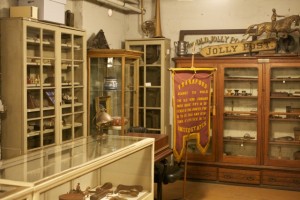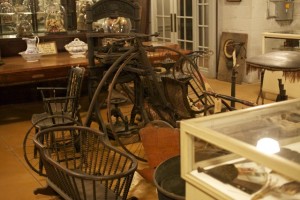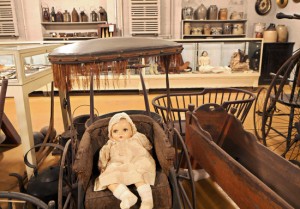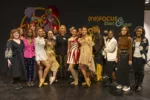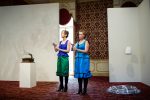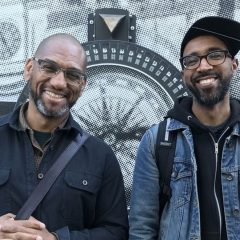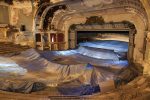For the duration of the 2013 Hidden City Festival, a series of sound installations created by artists associated with Data Garden will offer visitors a unique context for exploring the collection of objects and artifacts on display at the Frankford Historical Society in Northeast Philadelphia. Data Garden is a record label, events producer, and online journal that works to foment engagement with history and science through communally generated electronic music. For their installation in the Frankford Historical Society’s basement, Data Garden members and sound artists Dino Lionetti, Joe Patitucci, Laura Baird, King Britt, and Jacob 2-2 are exploring historical artifacts through sound and technology.
By creating an electro-mechanical “instrument” that plays a series of historically-inspired tape loops, which visitors activate via a central control panel, the artists look to offer new insights and bring fresh life to objects that, up until now, have only been experienced as artifacts in a traditional museums gallery context.
By wrestling these objects out of their historical context and providing a new angle at which to view them, Data Garden seeks to promote alternative conceptions of what constitutes a historical archive and what is a legitimate way of engaging with the historical.
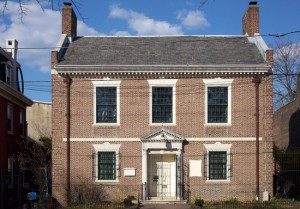
The basement museum of the Frankford Historical Society is a treasure trove for aficionados of 19th century Americana. Medicine bottles, crank generators, cradles, phonographs, antique fans and combs, lanterns, looms, and toys are just some of the medical, musical, domestic, infrastructural, technological, and geological objects that fill the room, lining the walls, resting in cabinets and display cases, and taking up large portions of floorspace.
Using this almost overwhelming variety as a jumping off point, each artist chose one or two objects or groups of objects from the collection to serve as inspiration for a sound composition. The eight final compositions were then recorded onto tapes, and each one was put into a different kind of tape player. Spread out around the space, the recordings are placed with the objects that inspired their creation. Visitors can then play the recordings from a central control panel by pressing one of 8 buttons, each corresponding to a different recording.
Recordings can be played individually or in any number of simultaneous configurations, allowing visitors to create unique sonic environments in real time.
The artists approach their compositions in a number of different ways. Some take a more deliberate approach: a composition inspired by a collection of exquisitely wrought fans and combs consists, in part, of harpsichord strings struck with tines of a comb. Another piece, inspired by an Omnibus generator, was made in part from recordings of Philadelphia’s trolley lines and manipulated subway tokens. A third, inspired by enormous bell jars riotously full of stuffed birds, features raucous, distorted bird calls.
Other contributions, however, seems more loosely inspired by their respective objects, looking more to convey a sense of the object rather than make some explicit reference to it.
A piece inspired by a collection of wooden cradles, for example, sounds like a ghostly, static-ridden lullaby. Another based on hand-cranked coffee grinders is formed from a series of immersive, jaggedly rumbling rhythmic loops. Finally, a piece inspired by wax phonograph cylinders has been bitcrushed, a kind of simulated digital decay that references the gradual degradation physical mediums like these cylinders go through naturally.
This idea of decay is intriguing to Data Garden, a point that is emphasized through the natural decay each of these tape loops will go through themselves as more and more visitors play them over the course of the festival.
The more magnetic tape is played, the more it deteriorates, causing the audio fidelity to fade and distort. By the end of the Festival, the potential sonic environments visitors can generate in the space will be fundamentally different, and far more distorted, than those created by earlier participants.
This is perhaps a commentary on the unfixed nature of historical interpretation, and a call for a more dynamic, multifaceted, and ever-evolving engagement with history and historical archives that eschews linear reductionism and simplistic explanations of our collective past.
Hidden City Festival 2013 runs from now until June 30th. To learn more, purchase tickets, or become a Hidden City member, click here.
All photos courtesy of Data Garden.


